Tutorial
Critical Thinking Skills Development: Boost Your Thinking Today
Let's be honest, "critical thinking" sounds like something you'd only hear about in a stuffy university lecture. But forget the academic jargon for a second. At its core, critical thinking is one of the most practical, powerful tools you can have for navigating life today.
This isn't some abstract skill for philosophers. It's for you—when you're trying to make a smart financial move, sift through the noise and misinformation online, or tackle a stubborn problem at work that just won't go away.
Your Secret Weapon in a World of Noise
Think of developing this skill as upgrading your mental operating system. It's the shift from passively scrolling and absorbing information to actively engaging with it. You start to see the cracks in a weak argument and appreciate the foundation of a strong one.
Ever seen a "too good to be true" offer or read a viral news story that just felt... off? That gut feeling is your critical thinking kicking in. It’s that internal voice that makes you pause and ask, "Okay, but where's the proof?" or "What am I just assuming to be true here?"
More Than Just a School Subject
The real power of critical thinking shows up when the stakes are real. It's the difference between blindly trying a questionable health trend you saw on social media versus actually checking the sources before you make any changes.
In the office, it's the skill that helps you find the root cause of why a project keeps getting delayed, instead of just slapping another band-aid on the symptoms.
When we don't think critically, the consequences are predictable and often painful:
* Financial hits: We fall for investment scams or make impulse buys driven by slick marketing, not actual need.
* Wasted time at work: We pour resources into "solutions" that don't even touch the real, underlying problem.
* Unnecessary conflict: We react based on emotion instead of taking a second to logically understand where someone else is coming from.
> Don't mistake critical thinking for being negative or just poking holes in everything. It's a constructive process. The goal is to get a clearer picture and find the best possible way forward—it's a tool for building, not just for tearing things down.
A Skill That's Here to Stay
Looking ahead, the ability to think clearly isn't just a nice-to-have; it's becoming absolutely essential. The future job market is banking on it.
With the flood of biased news and the sheer volume of content online, being able to step back and challenge information impartially is a massive advantage. In fact, forecasts show that by 2030, skills like analytical thinking and complex problem-solving will be in sky-high demand. This makes critical thinking a bedrock for career longevity. You can dig deeper into how these skills are shaping job markets of the future.
This guide is built to give you real, actionable strategies—not just theory—to start building this indispensable skill right now.
Unpacking Your Own Thought Process

If you want to build better thinking habits, you first have to get honest about your current ones. It's like a mechanic popping the hood before starting a repair; you need to see how all the parts are working together—or failing to—before you can make any real improvements.
This whole process of thinking about your own thinking has a name: metacognition.
It’s the bedrock of genuine critical thinking skills development. Research even shows a powerful link between the two. One study with university students found that better reasoning skills were a strong predictor of how aware someone was of their own thought processes. That awareness, in turn, was tied to greater empathy and well-being. If you're curious, you can read the surprising findings on how academic skills boost emotional capacities.
How We All Jump to Conclusions
Look, our brains are wired for efficiency, not necessarily for 100% accuracy all the time. To get through the day, we take mental shortcuts constantly, often without a second thought. A really handy way to visualize this shortcutting is the Ladder of Inference.
Picture yourself climbing a ladder. At the very bottom is the raw, objective data—the stuff you can actually see and hear. But with each rung you climb, you start filtering that data, layering on your own meaning, making assumptions, and eventually, landing on a conclusion.
Here’s a classic example: Your manager, Sarah, walks right past your desk without saying good morning.
* The actual data: Sarah walked past without speaking. That's it.
* The climb: You immediately think, "She's ignoring me" (you've just added meaning). Then it's, "I must have messed up that report" (making an assumption). Finally, you land at the top: "She's upset with my performance" (drawing a conclusion).
In the span of a few seconds, you’ve gone from a simple observation to a full-blown narrative about your job security, and it's all built on a shaky foundation. The first step to getting off this ride is just noticing when you're climbing and forcing yourself to walk back down to the facts.
Wearing Different "Thinking Hats"
Another fantastic framework for pulling apart your thought process is the Six Thinking Hats model. It’s a method for deliberately looking at a problem from multiple angles so you don't get stuck in your usual rut.
Each "hat" is a different style of thinking you can metaphorically pop on:
* White Hat: Just the facts. What information do we have and what do we need?
* Red Hat: Emotions and gut feelings. How do I feel about this? What's my intuition saying?
* Black Hat: The critic. What are the risks? What could go wrong?
* Yellow Hat: The optimist. What are the upsides and opportunities here?
* Green Hat: The creative. What are some out-of-the-box ideas or alternatives?
* Blue Hat: The manager. What's our goal? What's the next step to organize our thinking?
By going through the hats one by one, you force your brain out of its default mode. If you’re a natural Black Hat thinker (like me, sometimes), consciously putting on the Yellow Hat helps you see the benefits you'd otherwise completely miss.
> Key Takeaway: You don't have to be a victim of your own thought patterns. Frameworks like the Ladder of Inference and the Six Thinking Hats give you practical tools to observe, question, and redirect your thinking in a more structured and objective way.
Spotting Your Personal Biases
The final, and maybe toughest, piece of the puzzle is recognizing your own biases and emotional triggers. We all have them—those cognitive shortcuts that help us make sense of the world but can also lead us astray. It's crucial to get familiar with your own personal flavor of biased thinking.
Here’s a breakdown of some of the most common culprits. See which ones sound familiar.
Identifying Your Cognitive Biases
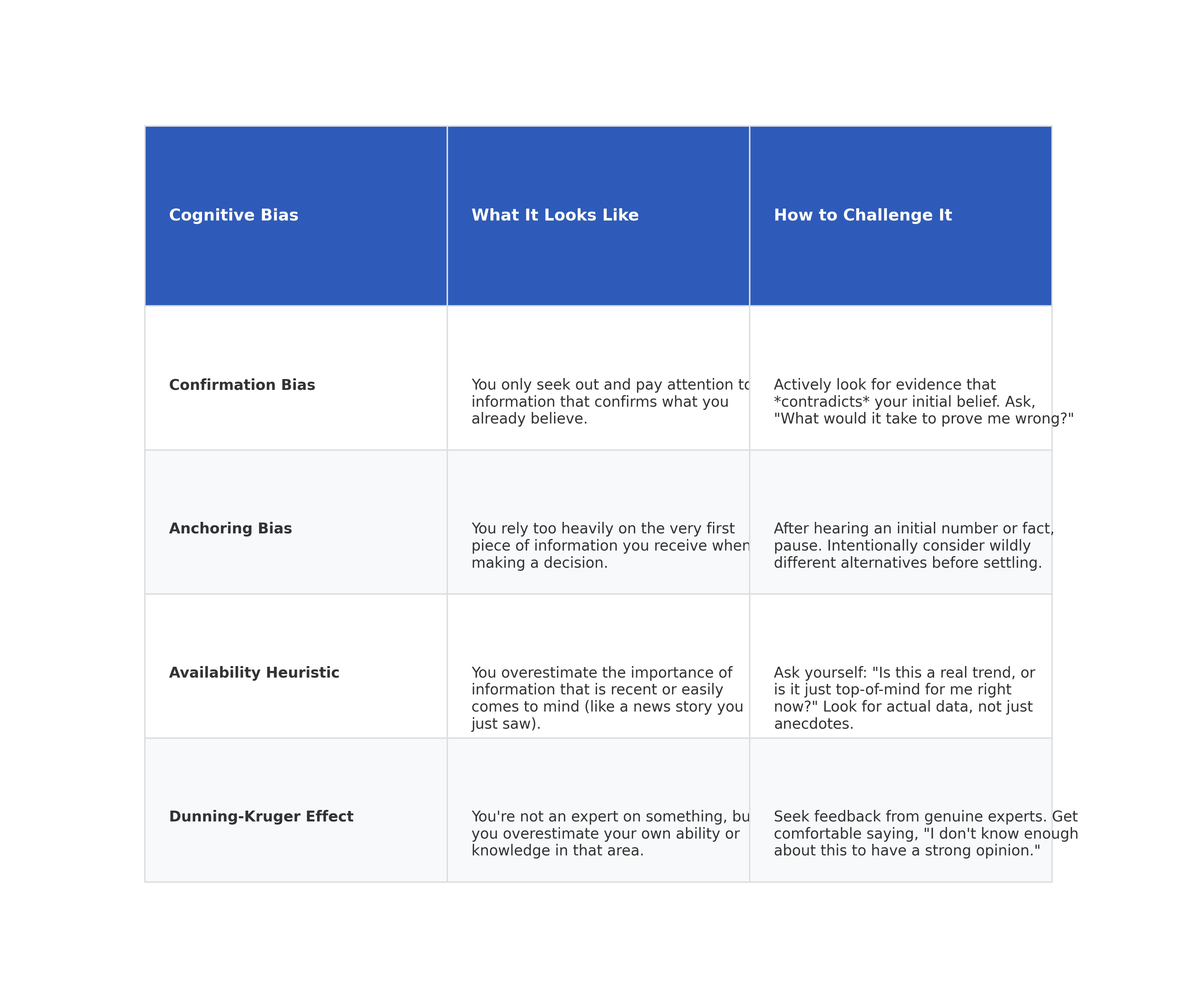
Recognizing these patterns in your own thinking is half the battle. When you can name the bias, you take away its power. It’s not about being perfect, but about being aware.
Think back to a recent disagreement you had. What was it really about? More importantly, how did you feel?
Ask yourself these gut-check questions:
1. What assumptions did I make? Did I assume their intentions were bad? Did I assume I had the full story?
2. What emotions were steering the ship? Was I feeling defensive, angry, or maybe a little insecure? How did that color my reaction?
3. Was I listening to understand or just to reply? Were you actually hearing them, or just waiting for a gap to make your point?
This kind of self-reflection can feel a bit raw, but it's incredibly insightful. It shows you the hidden scripts and emotional buttons that dictate your reactions. Once you can spot those patterns, you can start rewriting them.
Strengthening Your Core Analytical Abilities
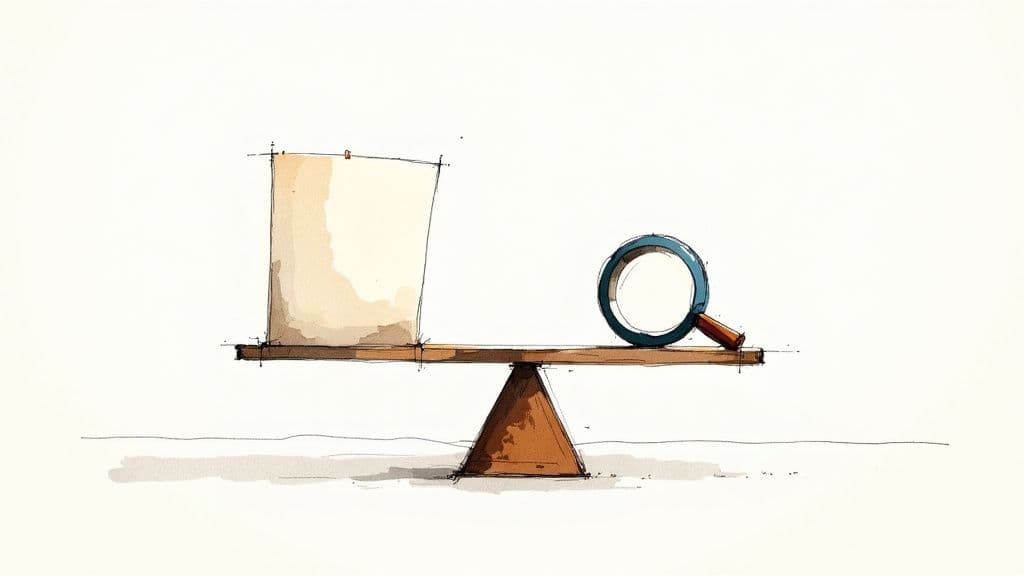
Thinking critically isn't some magic power you either have or you don't. It’s way more like a mental toolkit, with specific tools for different jobs. To really get good at this, you have to sharpen each one of those tools individually.
Most of us get plenty of practice with the basics, like analysis and inference. But other crucial skills often get left in the dust, creating some serious weak spots in our reasoning.
Data from the California Critical Thinking Skills Test (CCTST) actually backs this up. It shows that while college students are pretty good at analysis and explaining things, they often fall short when it comes to Interpretation, Deduction, and especially Evaluation and Numeracy. These are the very skills you need to judge arguments and make sense of data—absolutely vital for school and your career. You can dig into these trends yourself over at insightassessment.com.
So, let's break down these often-ignored skills and turn them into your strengths with some practical exercises you can start using right now.
Sharpening Your Evaluation Skills
Evaluation is basically the art of judging how credible and strong an argument really is. It’s about looking past the flashy headlines or emotional language to inspect the logical structure holding everything up. Think of yourself as a quality control inspector for information.
A solid evaluation means asking the right questions to poke and prod at an argument's foundation. It’s an active process, not a passive one.
To build this muscle, you need to dissect real-world stuff, not just abstract ideas. It takes a systematic approach to spot the weak points. And while it’s a different skill than memorization, you might find that some powerful memory techniques for studying can help you remember the key questions to ask when you’re in the moment.
Practical Exercise: Analyzing a Biased Article
Let's do this together. Go find a news article or an opinion piece that feels super biased—something that gets a strong emotional reaction out of you. Got one? Okay, now instead of just agreeing or disagreeing with it, let's put it under the microscope with this checklist:
* What’s the Main Claim? What's the one big thing the author wants you to believe? Boil it down to a single sentence.
* What's the Evidence? What facts, stats, or stories are they using to back it up? List at least three.
* Question the Evidence: Now, for each piece of evidence, ask: Can I verify this? Is the source legit? Could this data be spun in a different way?
* Spot the Emotional Language: Highlight any words clearly designed to make you feel something—angry, scared, excited. How much of the argument is built on emotion versus cold, hard logic?
* What’s Missing? What counterarguments or other points of view are they completely ignoring? A one-sided story is almost always a weak one.
Once you’re done, you’ll have a much clearer, more objective view of the article’s real strength, completely separate from its emotional pull.
Honing Your Deductive Reasoning
Deduction is all about moving from a general rule to a specific, logical conclusion. It’s classic detective work. If all the clues point in one direction, the conclusion is unavoidable. It’s all about precision.
For instance:
1. General Premise: All projects approved on a Friday must be reviewed by the legal team.
2. Specific Premise: The "Project Alpha" was approved last Friday.
3. Deductive Conclusion: Therefore, "Project Alpha" must be reviewed by the legal team.
Simple, right? The problem is, people often trip up on faulty premises or make logical jumps that break that chain of certainty.
> Key Takeaway: Deduction is about airtight logic. If the premises are true, the conclusion has to be true. The whole point of practicing this is learning how to spot even the tiniest crack in that logical chain.
Improving Your Numeracy and Data Literacy
Think of numeracy as critical thinking with numbers. We’re drowning in data, charts, and stats every single day. Being able to question and interpret numerical claims isn’t just a work skill anymore—it’s a life skill.
Misleading stats are everywhere, from ads to political speeches. A classic trick is throwing around percentages without any context.
Practical Exercise: Deconstructing a Misleading Statistic
Let’s say you see an ad for a new productivity app that boasts, "Our users saw a 200% increase in completed tasks!"
That sounds incredible. But a critical thinker immediately starts asking questions. Let’s pull this claim apart:
* What was the baseline? A jump from finishing one task a week to three tasks is a 200% increase. But that’s way less impressive than going from 50 tasks to 150. Without that starting number, the percentage is almost useless.
* Who were these users? Was this a study of 10,000 people over six months, or a hand-picked group of five super-users who were already highly motivated? The sample size and selection matter. A lot.
* How was "task completion" measured? Does just replying to an email count as a "task"? The definition is everything.
This quick deconstruction shows how a flashy number can hide a much less impressive reality. By turning abstract concepts like evaluation and numeracy into a hands-on toolkit, you can analyze information more sharply and make smarter decisions in every area of your life.
Use our Free AI Detector to check your content
Building Your Daily Critical Thinking Toolkit
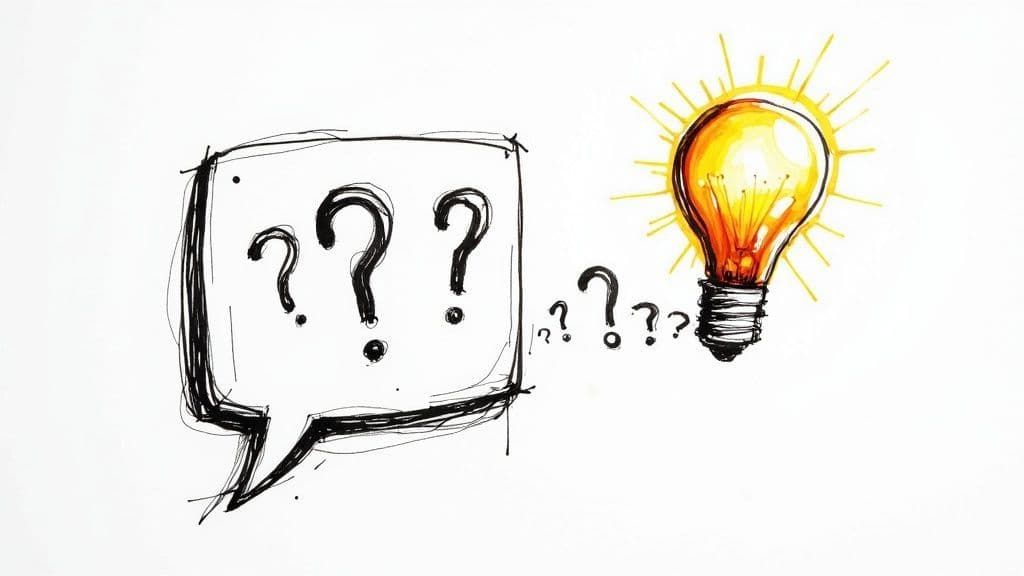
Knowing the theories behind critical thinking is a great starting point, but that knowledge alone won't sharpen your mind. The real gains come from consistent, daily practice—that’s how you build mental muscle. The goal is to get so comfortable with these skills that using them becomes second nature.
It’s just like hitting the gym. Reading about weightlifting won't make you stronger. True critical thinking skills development kicks in when you deliberately apply specific techniques to the problems and information you encounter every single day.
This section is your practical toolkit. These aren't just abstract ideas; they are actionable methods you can start using in your very next meeting, on your commute, or even while scrolling through your newsfeed.
Digging Deeper with Socratic Questioning
One of the most powerful tools in your kit has to be Socratic questioning. It’s a classic for a reason. This is a disciplined method for exploring complex ideas by asking probing questions that get to the core of the logic, assumptions, and evidence behind any statement. Instead of just taking things at face value, you become an active investigator.
The beauty of it is its simplicity. It’s not about winning a debate; it’s about a shared journey toward genuine understanding.
Let's walk through a real-world scenario. Your team is looking at a new marketing campaign proposal. Instead of just giving it a thumbs-up or thumbs-down, you can deploy a few Socratic questions to get a much clearer picture:
* Clarifying Questions: "You mentioned this will 'significantly increase engagement.' What specific metrics are we talking about here?"
* Probing Assumptions: "We seem to be assuming our target audience is active on this platform. What data are we basing that on?"
* Questioning Evidence: "The proposal points to a case study. How closely does that company's situation mirror our own?"
* Exploring Consequences: "If this campaign doesn't deliver, what are the potential hits to our budget and our brand's reputation?"
Using this approach can turn a surface-level conversation into a rigorous analysis, helping you spot the weak points before they become expensive problems.
Uncovering Hidden Beliefs with Assumption Hunting
Every decision you make and every opinion you hold is built on a foundation of assumptions. These are the beliefs we take for granted as true, often without a shred of proof. "Assumption hunting" is the active process of sniffing out and challenging these hidden beliefs—both in your own thinking and in others'.
This is a critical habit to build. Why? Because unexamined assumptions are the breeding ground for flawed reasoning. A single shaky assumption can bring an entire argument crashing down.
> An assumption is a belief without proof. Learning to spot them is like finding the secret blueprint to an argument. It shows you what the entire structure is really built on.
To start hunting for assumptions, get into the habit of asking yourself, "What must be true for this to be true?" anytime you hear a big claim. Say a colleague insists, "We have to switch to X software to boost our productivity." The hidden assumption might be that the current software is the main reason for low productivity. But is it? Or are other factors, like clunky workflows or a lack of training, the real culprits?
Visualizing Logic with Argument Mapping
For really complex issues, arguments can feel like a tangled knot of claims, evidence, and counterpoints. Argument mapping is a visual technique that helps you untangle that mess. You literally draw out the logical structure of an argument, creating a diagram that shows how different premises support a conclusion.
It might sound intense, but you can do it with just a whiteboard or a piece of paper.
* The Main Conclusion: Start by putting the main point at the top of the page.
* Supporting Premises: Underneath, list out all the reasons or pieces of evidence that back up that conclusion. Draw arrows from these premises up to the main point.
* Counterarguments: You can even map out objections or competing evidence, showing exactly which premises they challenge.
Breaking an argument down visually makes it incredibly easy to spot logical gaps, circular reasoning, or points that are backed by flimsy evidence. It forces a kind of clarity that’s tough to achieve when you're just reading a wall of text. It's also a fantastic way to organize your thoughts, which is a great first step when you need to create your own study guide on a complicated topic.
By making these three tools—Socratic questioning, assumption hunting, and argument mapping—a regular part of your routine, you'll transform the way you interact with information. You'll move from being a passive consumer to an active, engaged thinker.
Applying Critical Thinking to Real Life Scenarios
Knowing the theory is one thing, but putting it into practice is where critical thinking really flexes its muscles. It's easy enough to dissect a hypothetical problem in a classroom. It’s a whole different ball game when you're staring down a real project roadblock or trying to handle a sensitive personal issue.
This is exactly where your new mental toolkit proves its worth. Let’s bridge that gap and walk through a few detailed scenarios to see how these abstract concepts deliver concrete results when the stakes are real.
Tackling a Professional Challenge
Picture this: you're managing a project, and your team keeps missing deadlines for a big software launch. The knee-jerk reaction? Blame the team for being slow or just push all the future dates back. That’s just treating the symptoms, not the disease.
A critical thinking approach looks completely different. You don't jump to conclusions. You start asking questions and digging for data.
* Initial Analysis: You look at the workflow and notice that 75% of the delays are piling up during the quality assurance (QA) phase. Boom. That immediately narrows your focus.
* Deeper Inquiry: So, you talk to the QA team. It turns out they’re not getting the code from the developers until the very last minute, which leaves them no time for proper testing.
* Root Cause Identification: A quick chat with the developers reveals the real kicker: they're struggling with vague requirements from the product team, forcing them to constantly rewrite code.
The problem was never a "slow" team. It was a communication breakdown right at the start. The solution isn't to crack the whip on the QA folks; it's to create a rock-solid process for gathering requirements. This structured approach stops the bleeding and solves the problem for good.
> The core of critical thinking in the workplace isn't about having all the answers. It's about knowing which questions to ask to uncover the real problem hidden beneath the surface-level chaos.
Navigating a Personal Dilemma
Let's switch gears to something more personal. A close friend corners you, excited about some health advice they found online. They insist you try a new, super-restrictive diet, swearing it worked miracles for their cousin.
The common reaction is to either shut them down and risk hurting their feelings or, even worse, just accept the advice without a second thought. A critical thinker carves out a middle path.
First, you evaluate the source. You can politely ask where they got the info. Was it a peer-reviewed medical journal or a random blog trying to sell you something?
Next, you look for evidence and bias. A quick search of your own will tell you if the diet has any real scientific backing or if it’s just one influencer's opinion. You want consensus from reputable health organizations, not just anecdotes.
Finally, you consider the context—your own. Is this diet even appropriate for your specific health needs? What are the potential risks the rah-rah article conveniently forgot to mention?
Armed with this quick analysis, you can have a much better conversation. "Hey, I really appreciate you looking out for me. I did some reading, and my doctor actually recommends a different approach for my situation, but thanks so much for sharing." You've protected your health and the friendship.
This kind of careful evaluation is also critical for academic success. For students looking to build stronger, evidence-based arguments, here are 7 ways to improve your essays using these very same principles.
This chart breaks down just how much a structured approach matters.
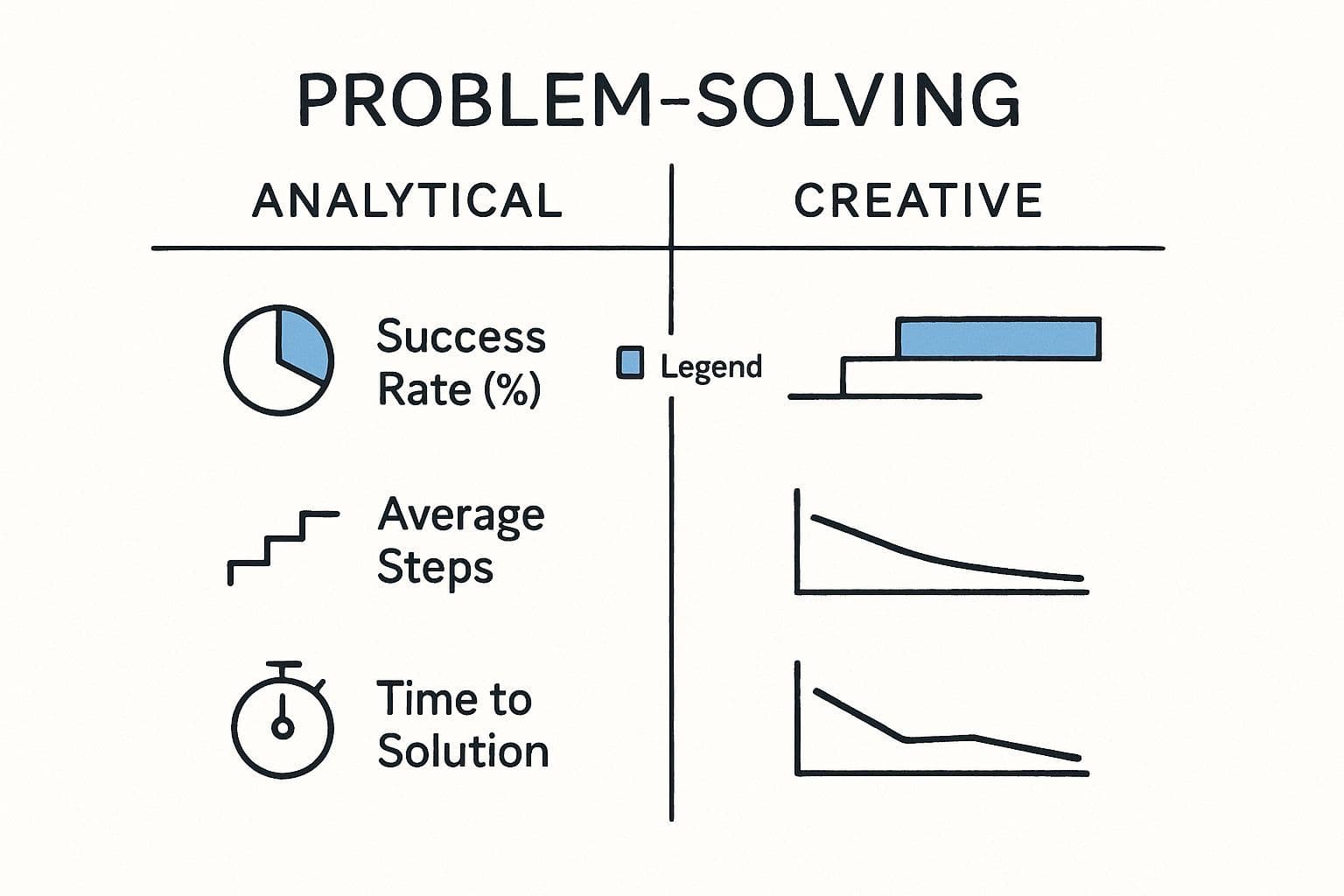
As the data shows, just winging it with a creative-only method doesn't get you very far. While a purely analytical approach can be slow, its success rate is way higher. The sweet spot is blending structured analysis with creative brainstorming—proof that a versatile mental toolkit is your best asset.
To make this even more practical, here’s a simple framework comparing reactive responses to critical thinking in a few common situations.
Critical Thinking Application Framework
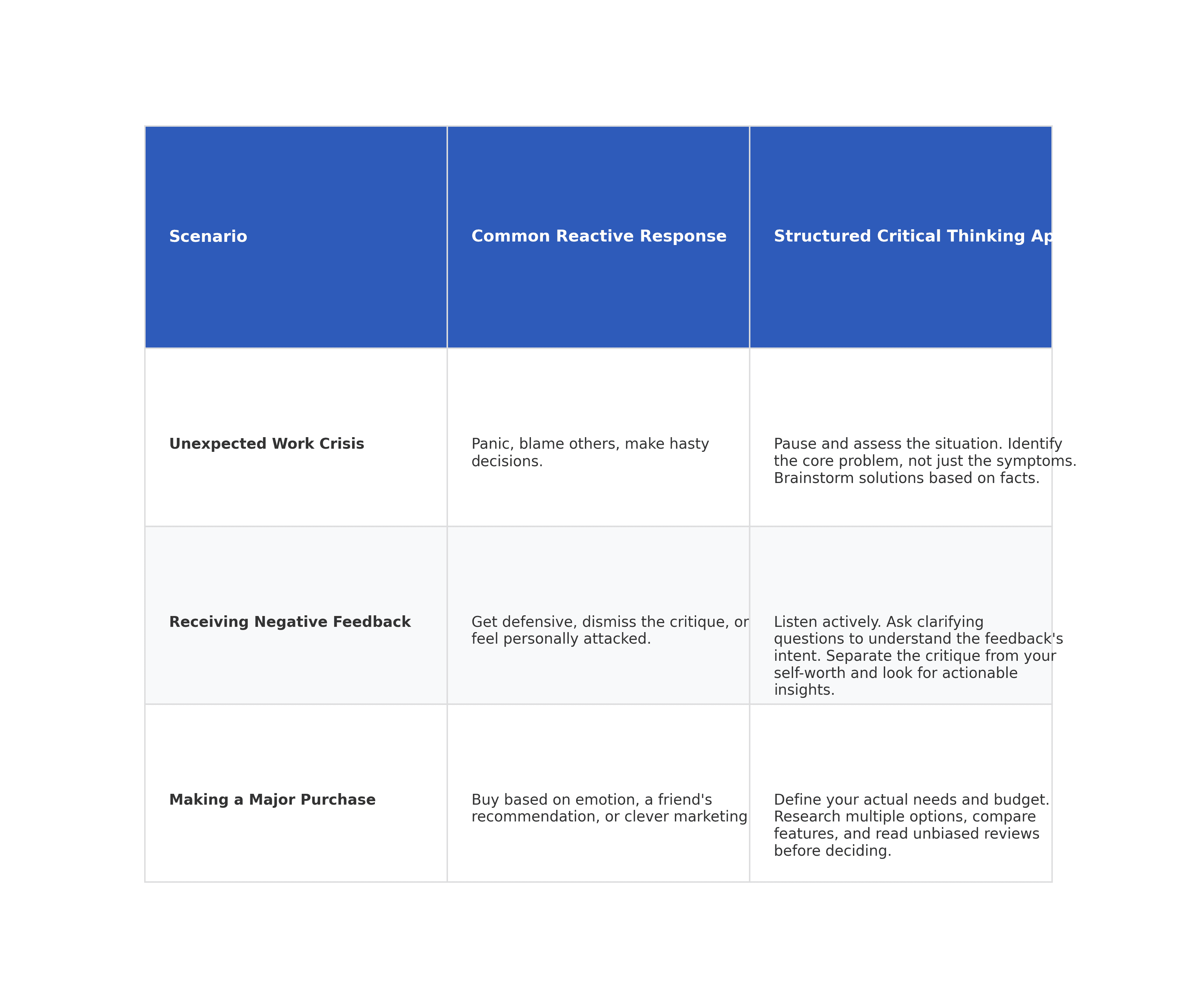
This table isn't exhaustive, but it highlights a key pattern: critical thinking replaces emotional, knee-jerk reactions with a deliberate, evidence-based process. By consciously choosing the structured approach, you consistently make better decisions, whether you're at the office or navigating your personal life.
Your Questions on Critical Thinking Answered
As you start flexing your critical thinking muscles, you’re bound to hit a few snags or have some questions pop up. That’s completely normal. Shifting from just accepting information to actively questioning and analyzing it is a major change in how you process the world.
This section tackles the most common questions and concerns we hear. Think of it as a field guide to help you navigate some of the trickier aspects of building this skill, from handling your own emotions to making sure healthy skepticism doesn't turn into full-blown cynicism.
https://www.youtube.com/embed/xZiqiALW2PM
Can You Be Too Critical?
This is a great question—and the answer is a definite yes. There's a fine line between thinking critically and just being cynical. When it’s not balanced, a critical eye can quickly devolve into negativity, finding fault in everything without offering a path forward. The real goal isn't just to poke holes in every argument; it's to find the clearest, most reasonable path to a solid conclusion.
So, how do you avoid falling into that trap?
The key is to practice what’s known as intellectual humility. It's a fancy term for a simple idea: reminding yourself that you don't know everything and that your own beliefs might be wrong. A powerful exercise here is to turn that critical lens back on yourself. Take one of your long-held beliefs and question it with the same rigor you'd apply to a new piece of information.
Another strategy is to frame your critiques constructively. Instead of shutting down an idea by saying, "That'll never work," try a more collaborative approach. For example: "I see a few potential hurdles with that idea, like X and Y. How could we tweak the plan to get ahead of those risks?" This simple shift changes the dynamic from opposition to problem-solving.
What Role Do Emotions Play?
Emotions are a huge, often invisible, force in our decision-making. Strong feelings—whether it's excitement about a new opportunity or anger at a perceived injustice—can completely bypass our logical brain. This makes us prime targets for our own cognitive biases.
A core part of becoming a better critical thinker is simply learning to spot when your emotions might be clouding your judgment. This skill is sometimes called emotional regulation. But don't mistake that for becoming a robot. It’s not about ignoring your feelings; it's about acknowledging them so they don't get to drive the car.
Before you make a big decision, especially if you feel yourself getting worked up, just hit pause. Ask yourself: "How is my current emotional state affecting the way I'm seeing these facts?" Taking a moment to create that mental space allows you to separate what's objective from what's subjective, leading to a much more balanced decision.
> Key Takeaway: Critical thinking isn't about getting rid of emotions. It's about understanding their influence and making sure reason and evidence have the final say, not just a gut reaction.
How Can I Practice Daily?
You don't need to block off hours on your calendar for "thinking time" to make critical thinking a habit. The best way is to weave small, deliberate practices into the things you're already doing every single day.
Here are a few simple ways to get started:
* When you read the news: Don't just scan the headline. Ask one question: "What's the original source for this claim?" A quick search can tell you a lot.
* In your next team meeting: A new strategy gets proposed. Instead of just nodding along, ask: "What's the strongest argument against this idea?" Playing devil's advocate can reveal blind spots.
* While listening to a podcast: Don't just be a passive listener. Actively challenge the host's main arguments in your head. Do they back them up with solid evidence, or is it mostly just strong opinions?
By piggybacking these small analytical tasks onto your existing routines, critical thinking stops being a chore and starts becoming a natural, almost automatic, part of how you operate.
---
Ready to take your writing and analysis to the next level? StealthGPT offers a suite of tools, from an AI Humanizer to an Essay Generator, designed to help you articulate your ideas with clarity and precision. Perfect for students and professionals, it’s the ideal assistant for anyone serious about improving their communication skills. Discover how you can write smarter, not harder, at https://stealthgpt.ai.
